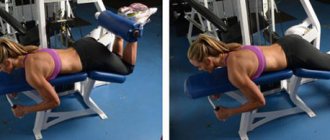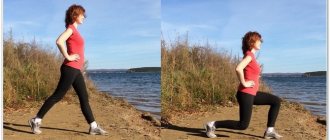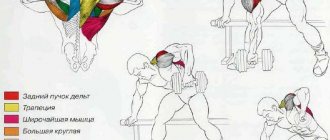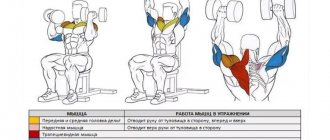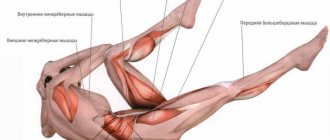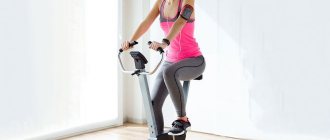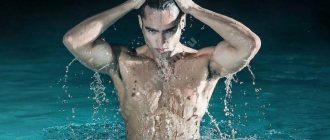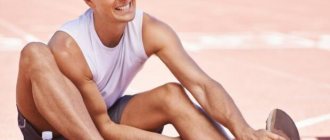The machine calf curl is a simple isolation exercise for the hamstrings. The person brings the heel to the buttock by contracting the biceps femoris and lowers the leg to the starting position. This exercise is performed by both beginners and those who have been involved in bodybuilding for a long time. The movement exists in a variant when the athlete lies face down on a bench, and when he performs a standing curl, bringing the heel of one leg towards the buttock. In classical training, there is a replacement - bending both legs with a dumbbell while lying down.
Execution technique
Initial position
- Much depends on the height of the athlete and the length of the bench of the machine, as well as on the position of the fixation cushion. It must be installed so that it is possible to start with “soft”, slightly bent knees, and so that the athlete can bring his heels to his buttocks without any problems;
- The support cushion should not roll onto the heel itself during movement, but should be located on the bend, in the area of the Achilles tendon;
- The weight is set depending on the experience and strength of the athlete, there is no need to set too much weight, this is not a movement to develop strength;
- To take the starting position, you need to lie face down on the bench and rest your feet on the exercise pad.
Movement
- It is enough to bend your knees so that your heels begin to move towards your buttocks, and bend your knees;
- The movement continues exactly until the heels rest on the buttocks, or until the volume of the hips and legs allows;
- At the peak of the amplitude, the biceps of the thigh are slightly tensed, and then the thigh is extended and the legs are lowered;
- The number of repetitions of the movement is from 10 to 20 or more, if necessary according to the athlete's training plan.
Attention
- Some lifters allow their hamstrings to rest during this exercise by extending their legs fully and popping their knees into a position that is typical for a deadlift. It is necessary to ensure that the tiles of the safety stops do not touch each other and that the exercise is performed with almost constant tone of the working muscle;
- The knee can and should be protected from injury if the athlete does not rest his kneecap on the pad of the exercise machine;
- There is no need to create a “swing” of the pelvis, an inertial movement that will contribute to hyperextension of the knee ligaments and injuries, and also take part of the load from the hamstring biceps;
- It is not recommended to actively move your ankles along and across the pad of the exercise machine. Such movements will contribute to Achilles tendon injuries;
- Activation of the hamstrings is possible without unnecessary movements, which many make, as if straightening their knees. This version of the exercise is quite traumatic for the ligaments, so it is not necessary to perform it.
It's the LYING LEG CURL, baby!
Recommendations
- Watch your body position on the bench. It is most convenient to bend your legs if the hip joint is on the “high” part of the bench, that is, on the place where it is highest;
- Do not push the pillow with your heels, and do not fidget on the bench;
- Try not to push your knees into hyperextension;
- Don’t struggle with weights, and don’t overload yourself with isolation exercises in general;
- If you use drop sets, make sure that the technique does not change as you get tired, and that your knees do not rest on the bench;
- Do not “drop” the weight so that the tiles of the machine hit each other;
- Do not lift the weight with your back, avoid excessively engaging the buttocks, this is not an exercise for them
Technique for performing single leg extensions in the simulator
If you have very noticeable asymmetry of the thigh muscles or have had an injury to one leg, you can perform this exercise with one leg. To increase the load, you can also do extensions alternately.
- Having adjusted all the necessary elements of the simulator, we take a comfortable position with a straight back.
- We place our foot under the bolster. If the machine has separate leg supports, we simply work with one leg. If there is only one roller, then you should move your foot to the center.
- As you exhale, extend your leg until your knees are straight. We hold the position for 1–2 seconds, after which we smoothly lower it down.
- Either we change the leg, or we repeat the required number of times.
If you do not have the appropriate indications, it is still undesirable to do the exercise on only one leg. You can do different numbers of sets and use different weights for each leg, but still work both.
Options
- Lying one leg bend . This variation is needed purely for variety, if, for example, the client gets tired of doing the same program all the time, and he needs something to make his life more interesting. The single leg curl is not very helpful, although it can help with injuries where you need to add extra weight to one leg;
- Standing bending . It can be performed in a special simulator or in a standard one. There is an opinion that this way the hamstrings contract more;
- Bend your toes in and out . Some bodybuilders believe that moving the toes in and out shifts the emphasis from the outer to the inner segment of the hamstrings. In fact, the knees do not allow this “operation” to be performed efficiently.
Analysis of the exercise
Anatomy exercises
What muscles work:
- The main mover is the thigh biceps; The popliteal, calf, and gluteal muscles help with movement. But in the version of working in simulators, the help of non-major muscle groups is minimal;
Benefits of Exercise
- Allows you to form a beautiful back surface of the thigh, works not only the biceps of the thigh as a whole, but also forms a beautiful “peak of the biceps”;
- Allows you to work with both one leg and two legs, ideal for those who have imbalances in muscle development;
- Training the hamstrings is necessary for those bodybuilders who avoid deadlifts and concentrate on squats. Bending will help protect the knees from injury due to uneven muscle development;
- It is convenient to pump the hamstrings on a bench with a “kink”; it allows you to reach a more stretched position and increase the amplitude, without increasing the load on the knee, and without overloading the cruciate ligament;
- The simulator allows you to achieve perfectly symmetrical muscle development
Flaws
- Sometimes athletes get their heels too low on the pad and their hamstrings are not isolated enough. In such a situation, it turns out that the calves become clogged and fail earlier than the hamstrings.
FITNESS. Video lesson “Lying leg curls in a simulator.”
Types of exercises and technique
Basic types of flexion exercises
In sports clubs you can most often find three main types of exercise equipment. They differ in the initial position of the body:
- Lying leg curls on a machine . The exercise machine is a horizontal bench. There are hand grips underneath it in front, and a leg bolster at the back. There is a load adjuster located on the side of the bench; you can use it to set the required weight. Starting position: set the desired weight, lie on a bench, place your calves under the roller, and grab the handles with your hands.
- Seated bending . Unlike the first option, here the bench has a back, the handles are located on the sides of the seat or on the upper bolster, one bolster is fixed in front, and the second is at the bottom. Starting position: set the weight, sit on the seat of the exercise machine, press your back tightly against the backrest, place your hips under the upper bolster, and your calves over the lower one.
- Standing bending . The location of the simulator is vertical. Two supports - for the stomach and hips - are located at an angle to each other. There are handles on the top stop, a roller at the bottom, and a weight regulator on the side. The main difference is that the legs only bend alternately. In the first two options, you can bend two legs at once or alternately one leg at a time. Starting position: set the weight, lean against the supports with your hips and stomach, place the calf of the working leg under the roller, the other leg remains the supporting leg.
Some machines do not have a weight adjuster and instead require you to independently hang the weights on pins located on a bolster or on the side of the machine.
Execution technique
Before performing the exercise, you must carefully study the technique of its implementation. Regardless of body position (lying, sitting or standing), recommendations for the correct execution of the exercise will be as follows:
- The body maintains a clearly fixed position throughout the entire approach - the back is straight, a slight arch in the lower back, the abs are tense. Hands hold the handles tightly - this will help maintain the desired position of the body.
- The hips are pressed as close as possible to the bench. In a lying and standing position, the front surface of the thigh is pressed tightly, and the knees slightly extend beyond the border of the bench. In a sitting position, the back surface is pressed against the seat, and the back is pressed against the back of the seat.
- Breathing is not held. When bending, exhale through the mouth, and when returning the legs to their original position, inhale through the nose.
- At the end point of the movement, you need to squeeze the muscles of the hips and buttocks as much as possible.
- The weight must be lowered smoothly - throwing the weight down is unacceptable.
- It is important to remember that the movement is not accomplished by jerking the shin, but by contracting the hamstring muscles.
- The first set is done with little or no weight to prepare the muscles, joints and ligaments for work.
- Changing the position of the foot inward shifts the emphasis to the inner part of the biceps femoris, and when moving the foot outward, the outer part of the muscle will be more involved in the work.
- At the end of the workout or after completing the approaches, perform stretching. Photos of stretching exercises can be found on the Internet.
Preparing for the exercise
Some athletes really like to write about preparing for this exercise; they include hamstring stretching, some “warm-up” exercises, etc. in the program. In practice, all this is not necessary. Isolation movements are performed after basic exercises. Usually the muscles are already sufficiently filled with blood and elastic to allow the movement to be performed efficiently.
In fact, if this is the first exercise in the plan for some reason, it is worth including a stepper during your cardio warm-up, and starting with light weights during work. Most curling machines have an adjustable pad that we rest our feet on. It should be adjusted carefully enough so that the calf muscles do not become clogged during movement. This problem is the main reason why most athletes fail to benefit from movement.
Proper execution
- It is not allowed to bend the legs at the knee by lifting the pelvis. This option will be quite harmful, as it can lead to lower back injury if the angle in the joint is disturbed. Usually, if there is a strong lift of the pelvis, it is recommended to reduce the load and remove excess weight;
- You should not sharply push the exercise pad up and lift the weight due to inertia. Untrained knee ligaments can be injured if you work unevenly, and many machines are designed to transfer the load from an unevenly moving cable to the knee;
- You should slowly bend your legs, hold in the peak contraction, and just as smoothly straighten your legs in order to get a load and not get injured;
- If you cannot work smoothly, concentrating flexion on exhalation, it is recommended to remove the load and work with less resistance from the machine;
- It is better not to rest the kneecap on the exercise machine bench, if there is such a constructive possibility;
- The feet must be kept parallel to each other and not rotated with the toes during the exercise. It is ideal if the athlete does not maintain the distance between the knees while performing the exercise.
Errors
- You cannot rest your knees on the bench;
- It is not allowed to push the weight in jerks;
- If the training plan does not provide for this, movement at a reduced amplitude is not recommended;
- It is better to avoid actively involving your hands in the work, do not “cling” with them to the handles of the simulator;
- Do not lift your pelvis when working
Features of the exercise
Leg bending in a lying down machine, or alternatively, sitting and standing (there are also such machines) is one of the most popular exercises in both women's and men's lower body training. This is explained, firstly, by the ease of mastering the technical side of the movement, and secondly, by the opportunity to qualitatively work out the target muscles.
By the way, about muscles. The target muscles when performing calf curls will be:
- Biceps femoris or biceps muscle. It bears the main load.
- Semitendinosus and semimembranosus muscles. They are located closer to the inside of the leg. Just like the biceps femoris, these muscles bend the leg at the knee joint.
- The calf muscles are additionally involved in the work.
Load distribution: biceps femoris, semimembranosus, semitendinosus and gastrocnemius muscles.
As for the place of this exercise in training, it is usually performed, like leg extension, after basic exercises for the legs and buttocks, in particular, after squats or deadlifts. The number of sets and repetitions may vary depending on your goals. As a rule, this is 3-4 approaches of 15-20 times.
- Girls perform this exercise in multiple repetitions with light weight. This approach works for fat burning, allows you to increase muscle tone and draw relief.
- Men do fewer repetitions, but with heavier weight. Thus, the hamstrings increase in volume and muscle strength increases. And this, in turn, not only adds mass to the legs, but also provides significant support when performing basic exercises.
With the correct technique, leg curls on the machine are quite safe and are recommended even for beginners. However, if you have had injuries to your knees or lower spine, be careful.
Classic version of the exercise: in a lying position.
Leg bending while sitting and lying down is practically no different in effect. Choose the position that is most comfortable for you. Doing leg curls while sitting will make it easier for you to breathe because your chest won't be compressed, and lying down will make it easier to control the range of motion of the weight. Also, some athletes do bending alternately with one and the other leg while standing in a special machine. This allows you to better feel the hamstrings. There are many variations and you can always replace one with another.
Bending the legs on the machine while standing.
If you don’t have a simulator at all, you can replace this exercise with leg curls with dumbbells held between your feet. In this case, you lie down on the bench with your stomach.
Adviсe
- Avoid “ballet foot”, that is, stretching the toe forward and, as it were, pushing it away from the center of the arch of the foot;
- It is not recommended to perform work by hyperextending the femoral biceps and “reverse” extension in the knee joint. But if possible, it is better to work on a machine with a bench with a “kink” on which you should rest your hip joint;
- Toes point towards the foot
When to expect an effect
Leg extension in a sitting machine, included in the training process and performed in accordance with the specified recommendations, can bring results in 2-3 weeks, that is, after 2-3 full workouts. The effect of the exercises is manifested in the form of clearer outlines of the medial head of the femur and a clear separation between the other 3 groups of muscle fibers.
Straightening the legs at the knee joint on a sports machine is a universal tool for achieving your goals. Despite performing the exercise from a sitting position, it does not provide rigid fixation for the back muscles. But adherence to the training technique and the correct selection of the load make it an indispensable tool in the athlete’s arsenal.
Inclusion in the program
This movement should not be a stand-alone exercise on leg day, and it should not replace the base, as well as some of the rows performed with a hyperextended hamstring. The movement should be done after basic hamstring exercises on the appropriate day if the athlete is splitting leg day.
The exercise can be performed for 10-12 repetitions, or for more. It all depends on the individual muscle response. In strength disciplines, this movement is not performed in more than 3-4 sets of 10 repetitions. In bodybuilding, other options are possible. Some athletes perform overload-style movements, use drop sets, and various other techniques to increase the intensity of the load.
Leg bending while lying on a machine[edit | edit code]
Source:
“Bodybuilding.
Book trainer" .
Editor:
Oksana Usoltseva
Ed.
: Eksmo 2013
Lying leg curl on a machine
Inventory
:training apparatus.
Muscles working when bending the legs on a lying machine: 1 - semimembranosus;
2 - biceps femoris muscle; 3 - semitendinosus; 4 - gastrocnemius Basic muscles
: back of the thigh.
Additional muscles
: calf.
Level of training
: from beginner to advanced.
The main load falls on the back of the thigh.
Step 1
. Lie face down on the machine with the bolsters slightly higher than your heels.
Step 2
. As you exhale, slowly bend your knees with maximum amplitude.
Step 3
. As you inhale, slowly return to the starting position.
Make sure that during movement the body does not lift off the surface of the simulator, as this will remove the load from the thigh muscles, redistributing it to the gluteal muscles. The option in which bending is performed with one leg is perfect for isolated training and for inharmonious development of the hips.
Contraindications
- This movement is not suitable for some athletes due to anthropometry. They can only do it with their knees resting on the bench due to their short stature. These people should switch to standing bending;
- You should not perform the exercise if you have recently had a knee injury, or there is a high risk that the soft tissue around the joint will become inflamed due to overuse;
- This exercise should not be performed when the piriformis muscle is cramping (this is a condition where pain in the buttock radiates to the leg after performing deadlifts), then the movement will almost certainly be due to the lifting of the pelvis, and the lifter will not receive the necessary load on the hamstrings;
- Movement is not recommended for Achilles tendon and ankle injuries;
- It is best to avoid if there is injury to the lumbar spine.
Muscles involved
The exercise works the muscle groups of the legs, so it is not surprising that many athletes always work in the gym with such a simulator.
There are between 640 and 850 muscles in the human body, and 200 of them are used during walking.
Basic
This is an isolated exercise for the hamstrings. For this reason, girls especially loved it.
Additional
Additionally, the work includes the popliteal, calf and gracilis muscles. In addition to them, the tibialis anterior and rectus femoris muscles work as stabilizers.
Interesting Facts
- According to scientific research, it turns out that turning your toes still matters
- When you turn your toes to the side, it turns out that the outer sides of the thigh receive more load;
- If you connect your socks, the inner thigh will receive more stress
- Ronnie Coleman believed that this movement was great for developing massive thighs. But it should not be performed as the first movement, but only after lunges, squats, and Romanian deadlifts. You should do this exercise exclusively at the end of your workout.
Coleman advised doing this movement at the end of the workout, for 12-15 repetitions in 3-4 sets.
Alternatives
- If you go to the gym without a leg curl machine, you can act like the old school athletes. You need to use dumbbell leg curls while lying face down;
- The load can be simulated on the lower block of the crossover, then the leg can be alternately fastened to the lower block using a cuff;
- The third option, which is suitable for beginners and people who should not overload their hips, is to work with a fitness band. It is secured to a furniture leg, or some other vertical support, and draped over the foot so that it does not slip. Next, you need to perform bending with an elastic band while standing to get the active involvement of the thigh muscles in the work;
- The easiest option is a standing leg curl with ankle weights. It is performed standing on a steppe or other support. It is suitable only for completely beginner athletes, for whom this weight will be enough;
- Training for beginners also involves performing bending while lying face down with weighted cuffs. You can do this movement one leg at a time, wearing several fitness weights on each leg.
Leg curls are a good isolation exercise for the hamstrings. For most people, a simple rule works - you need to perform as many flexions as extensions. But if an athlete has too developed quadriceps, he should focus on bending his legs.
Errors and technique for performing lying leg curls
Igor April 18, 2019
How to diversify your workout: how to replace bending, example of a workout
Alternative options
- Curls with weights . Instead of exercise equipment, you can use weights. The exercise is performed lying on the floor or bench, as well as standing. The technique and movements remain the same.
- Lying on a bench with a dumbbell . You can use a dumbbell as a weight. Execution: lie on your stomach on a bench, clasp the handle of a dumbbell with your feet so that the flat part of the dumbbell rests on the soles of your closed feet, perform a series of bends.
- Bending with an elastic band (expander) . It is most convenient to do while standing. Secure the elastic band to the ankles or soles of both legs. Take the starting position standing. The knee of the supporting leg is slightly relaxed. The back is straight. You can rest your hands on a wall, chair or any other stable surface. Perform alternating bends with the right and left leg.
- Bending in "Crossover" . You can also perform the previous exercise in the gym, using the Crossover exercise machine instead of an elastic band. Execution: fasten the cuff to the lower block, put it on the working leg, set the weight, then with a straight back and slightly bent knees, stand with your back to the control block with weights and perform a series of bends, then repeat this on the other leg.
Example workout
This workout includes a leg curl exercise.
- Warm-up: 5-10 minutes of running in place or on a treadmill.
- Bending (any option described above) with the right leg 15 times, then 15 times with the left and both legs 20 times. Run without interruption. This is one approach. Make 5 of these.
- Extensions in the simulator 15 times with weights or 30 times without weights. Do three approaches.
- Rest two minutes. All together is one circle. Such circles (flexion plus extension) need to be done from three to seven, depending on physical fitness.
- At the end, do some stretching.
Leg curls can be included in both home workouts and gym workouts.
This exercise is suitable for both beginners and experienced athletes. Beginners should first carefully study the technique of execution and not chase heavy weights, since it is not the amount of weight, but the correct execution of the exercise that will lead to results faster. Leg curls in the simulator

